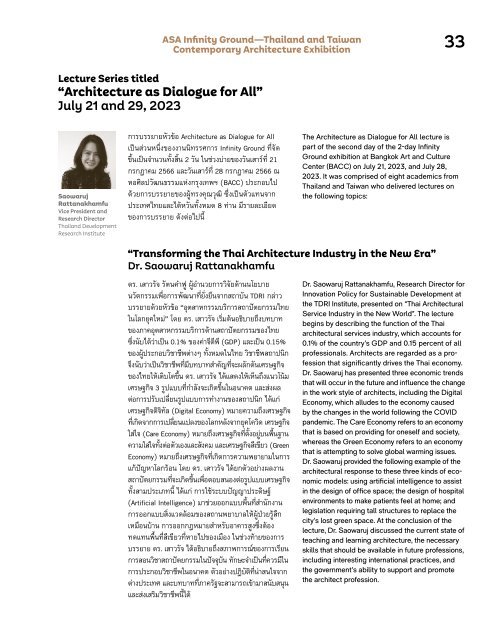ASA JOURNAL 14/2023
You also want an ePaper? Increase the reach of your titles
YUMPU automatically turns print PDFs into web optimized ePapers that Google loves.
<strong>ASA</strong> Infinity Ground—Thailand and Taiwan<br />
Contemporary Architecture Exhibition<br />
33<br />
Lecture Series titled<br />
“Architecture as Dialogue for All”<br />
July 21 and 29, <strong>2023</strong><br />
Saowaruj<br />
Rattanakhamfu<br />
Vice President and<br />
Research Director<br />
Thailand Development<br />
Research Institute<br />
การบรรยายหัวข้อ Architecture as Dialogue for All<br />
เป็นส่วนหนึ่งของงานนิทรรศการ Infinity Ground ที่จัด<br />
ขึ้นเป็นจำานวนทั้งสิ้น 2 วัน ในช่วงบ่ายของวันเสาร์ที่ 21<br />
กรกฎาคม 2566 และวันเสาร์ที่ 28 กรกฎาคม 2566 ณ<br />
หอศิลปวัฒนธรรมแห่งกรุงเทพฯ (BACC) ประกอบไป<br />
ด้วยการบรรยายของผู้ทรงคุณวุฒิ ซึ่งเป็นตัวแทนจาก<br />
ประเทศไทยและไต้หวันทั้งหมด 8 ท่าน มีรายละเอียด<br />
ของการบรรยาย ดังต่อไปนี้<br />
The Architecture as Dialogue for All lecture is<br />
part of the second day of the 2-day Infinity<br />
Ground exhibition at Bangkok Art and Culture<br />
Center (BACC) on July 21, <strong>2023</strong>, and July 28,<br />
<strong>2023</strong>. It was comprised of eight academics from<br />
Thailand and Taiwan who delivered lectures on<br />
the following topics:<br />
“Transforming the Thai Architecture Industry in the New Era”<br />
Dr. Saowaruj Rattanakhamfu<br />
ดร. เสาวรัจ รัตนคำาฟู ผู้อำานวยการวิจัยด้านนโยบาย<br />
นวัตกรรมเพื่อการพัฒนาที่ยั่งยืนจากสถาบัน TDRI กล่าว<br />
บรรยายด้วยหัวข้อ “อุตสาหกรรมบริการสถาปัตยกรรมไทย<br />
ในโลกยุคใหม่” โดย ดร. เสาวรัจ เริ่มต้นอธิบายถึงบทบาท<br />
ของภาคอุตสาหกรรมบริการด้านสถาปัตยกรรมของไทย<br />
ซึ่งนับได้ว่าเป็น 0.1% ของค่าจีดีพี (GDP) และเป็น 0.15%<br />
ของผู้ประกอบวิชาชีพต่างๆ ทั้งหมดในไทย วิชาชีพสถาปนิก<br />
จึงนับว่าเป็นวิชาชีพที่มีบทบาทสำ าคัญที่จะผลักดันเศรษฐกิจ<br />
ของไทยให้เติบโตขึ้น ดร. เสาวรัจ ได้แสดงให้เห็นถึงแนวโน้ม<br />
เศรษฐกิจ 3 รูปแบบที่กำาลังจะเกิดขึ้นในอนาคต และส่งผล<br />
ต่อการปรับเปลี่ยนรูปแบบการทำางานของสถาปนิก ได้แก่<br />
เศรษฐกิจดิจิทัล (Digital Economy) หมายความถึงเศรษฐกิจ<br />
ที่เกิดจากการเปลี่ยนแปลงของโลกหลังจากยุคโควิด เศรษฐกิจ<br />
ใส่ใจ (Care Economy) หมายถึงเศรษฐกิจที่ตั้งอยู่บนพื้นฐาน<br />
ความใส่ใจทั้งต่อตัวเองและสังคม และเศรษฐกิจสีเขียว (Green<br />
Economy) หมายถึงเศรษฐกิจที่เกิดการความพยายามในการ<br />
แก้ปัญหาโลกร้อน โดย ดร. เสาวรัจ ได้ยกตัวอย่างผลงาน<br />
สถาปัตยกรรมที่จะเกิดขึ้นเพื่อตอบสนองต่อรูปแบบเศรษฐกิจ<br />
ทั้งสามประเภทนี้ ได้แก่ การใช้ระบบปัญญาประดิษฐ์<br />
(Artificial Intelligence) มาช่วยออกแบบพื้นที่สำานักงาน<br />
การออกแบบสิ่งแวดล้อมของสถานพยาบาลให้ผู้ป่วยรู้สึก<br />
เหมือนบ้าน การออกกฎหมายสำาหรับอาคารสูงซึ่งต้อง<br />
ทดแทนพื้นที่สีเขียวที่หายไปของเมือง ในช่วงท้ายของการ<br />
บรรยาย ดร. เสาวรัจ ได้อธิบายถึงสภาพการณ์ของการเรียน<br />
การสอนวิชาสถาปัตยกรรมในปัจจุบัน ทักษะจำาเป็นที่ควรมีใน<br />
การประกอบวิชาชีพในอนาคต ตัวอย่างปฎิบัติที่น่าสนใจจาก<br />
ต่างประเทศ และบทบาทที่ภาครัฐจะสามารถเข้ามาสนับสนุน<br />
และส่งเสริมวิชาชีพนี้ได้<br />
Dr. Saowaruj Rattanakhamfu, Research Director for<br />
Innovation Policy for Sustainable Development at<br />
the TDRI Institute, presented on “Thai Architectural<br />
Service Industry in the New World”. The lecture<br />
begins by describing the function of the Thai<br />
architectural services industry, which accounts for<br />
0.1% of the country’s GDP and 0.15 percent of all<br />
professionals. Architects are regarded as a profession<br />
that significantly drives the Thai economy.<br />
Dr. Saowaruj has presented three economic trends<br />
that will occur in the future and influence the change<br />
in the work style of architects, including the Digital<br />
Economy, which alludes to the economy caused<br />
by the changes in the world following the COVID<br />
pandemic. The Care Economy refers to an economy<br />
that is based on providing for oneself and society,<br />
whereas the Green Economy refers to an economy<br />
that is attempting to solve global warming issues.<br />
Dr. Saowaruj provided the following example of the<br />
architectural response to these three kinds of economic<br />
models: using artificial intelligence to assist<br />
in the design of office space; the design of hospital<br />
environments to make patients feel at home; and<br />
legislation requiring tall structures to replace the<br />
city’s lost green space. At the conclusion of the<br />
lecture, Dr. Saowaruj discussed the current state of<br />
teaching and learning architecture, the necessary<br />
skills that should be available in future professions,<br />
including interesting international practices, and<br />
the government’s ability to support and promote<br />
the architect profession.


















